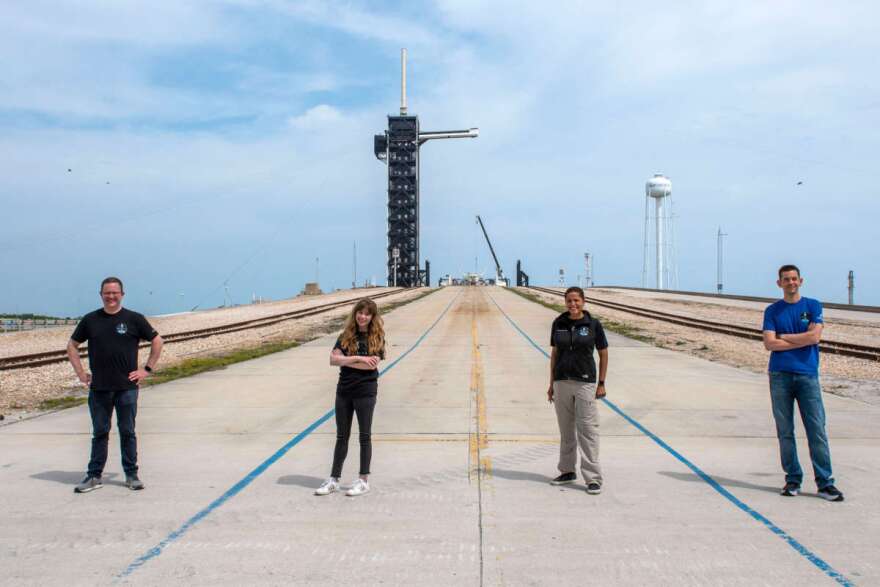Four ordinary people are heading to space, launching on SpaceX’s Crew Dragon spacecraft from Kennedy Space Center in Florida on September 15.
While it’s only a three day mission to low-Earth orbit, the crew will be testing new medical technology that will help future astronauts spend more time and travel farther in space.
The crew is performing four experiments in orbit for the Translational Research Institute for Space Health (TRISH).
That’s why Inspiration4 is such an important and historic mission for the future of space travel. The crew will be testing health technologies that could change the course of how astronauts travel in space and could help future human missions into deep space.
TRISH interim chief scientist and chief medical officer Dr. Emmanuel Urquieta said all of the technologies that are being deployed on this mission can be used for future missions in space.
One of the technologies being tested on this mission is a miniaturized ultrasound, which is a handheld device that you can connect to a cell phone and it will guide the user on how to conduct an ultrasound, even if they are not a medical professional.
The second device will use a single drop of blood to search for medical issues of astronauts as they travel in space.
“This is going to be done in real-time,” said Urquieta. “Imagine a larger lab that you would have on Earth, like when you go to the doctor and they get 10 to 12 CCs of blood, [this technology] could do some of the same capabilities, but with a single drop of blood in real-time. In space.”
The third experiment is in cognition, examining the psychological health of the crew during the mission. The crew will also test their sensory-motor adaptation to evaluate how their senses change for the final experiment.
These technology demonstrations and experiments are a collective effort. They were funded at different institutions around the United States, including NASA.
“There’s a large group of incredible investigators behind these and we’re very lucky to be able to have them with us,” Urquieta said.
These concepts are going to be extremely important for deep space exploration like going to the moon and Mars. Having handheld ultrasound equipment to diagnose any issues when you’re on a multi-month trip to Mars or being able to do blood work with a very small sample size almost in real-time will be beneficial to deep space astronauts.
What’s propelling this research? It’s the fact that humans want to go farther and longer into space. Researchers are going to need to figure out how the human body adapts to this to keep them alive.
“The technology is cool, but there will be a repository of data,” said Urquieta. “It’s going to study how technology goes in space. They are going to share it with other institutions and other scientists to be able to come up with answers to be longer in space.”
TRISH plans to share its findings with other institutions and scientists. The institute is also developing a biobanking capability that would allow researchers to study the blood, urine and saliva of the crew and share it with other investigators outside of TRISH. The aim is to provide critical data to scientists working on studies and technologies to help deep space traveling astronauts.
“That’s what we need to solve, to go safely to the Moon and Mars, said Urquieta. “This is a long investment and a long effort that we’re just starting now.”
On the Inspiration4 mission, crew member Haley Arceneaux, a medical professional at St. Jude, will serve as chief medical officer. But having someone with medical experience on a spaceflight mission is not always the case. While missions will have a person in charge as the medical officer, they might not have previous professional experience.
That’s why during this mission, TRISH will be looking at how someone with medical training performs during these experiments versus the other crew members on Inspiration4 who don’t have those levels of medical training.
The Inspiration4 mission came together quickly, with billionaire backer and Inspiration4 commander Jared Isaacman along with SpaceX’s Elon Musk announcing the mission back in February. TRISH has worked tirelessly to make sure that their technology is ready to come aboard for the September 15 launch in just few months.
“The crew of Inspiration4 is eager to use our mission to help make a better future for those who will launch in the years and decades to come,” said Isaacman. “In all of human history, fewer than 600 humans have reached space. We are proud that our flight will help influence all those who will travel after us and look forward to seeing how this mission will help shape the beginning of a new era for space exploration.”
Copyright 2021 WMFE. To see more, visit WMFE.



